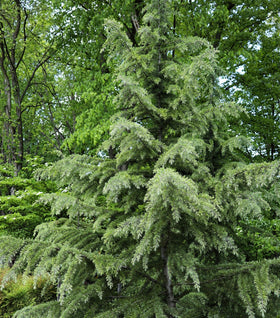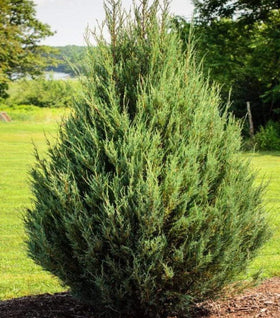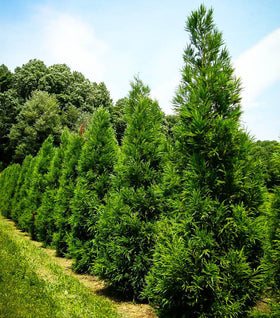Cedar Trees
Looking for year-round structure with irresistible fragrance and texture? Our Cedar Trees collection brings together iconic species and cultivars—Deodar Cedar for graceful, swooping branches; Blue Atlas Cedar for steel-blue architecture; Eastern Red Cedar for native toughness and wildlife value. Each tree is chosen for reliability, clean color, and strong form in real-world landscapes.
When you buy cedar trees online from Garden Goods Direct, you get nursery-grown, zone-appropriate stock with clear sizing, spacing, and care—backed by our "We Grow Together" Promise. Whether you’re framing an entry, building a wind-filtering screen, or adding a sculptural focal point, these cedars deliver low-maintenance performance and timeless style.
Cedar trees are landscape workhorses with four-season presence—plumey sprays or needled fans, resinous fragrance, and silhouettes that range from formal pyramids to artful weepers. Our lineup spans Deodar (Cedrus deodara) for fast, elegant growth; Blue Atlas Cedar (Cedrus atlantica ‘Glauca’) for bold, blue architecture; Eastern Red Cedar (Juniperus virginiana) for native durability and birds; plus Japanese Cedar (Cryptomeria).
We prioritize trees with balanced root systems, strong central leaders, and consistent color—traits that shorten establishment time and maintain dense, attractive canopies with minimal intervention.
Growth Habits & Seasonal Interest of Cedar Trees
Deodar Cedar: broad pyramidal form, soft, drooping tips, and quick juvenile growth—instant sophistication in larger spaces.
Blue Atlas Cedar: striking steel-blue needles, stout branching, and architectural trunks that age beautifully.
Eastern Red Cedar: native, upright and adaptable; fine textured year-round with bluish berry cones that feed birds.
Deodar Cedar: tall spires with pendulous curtains of foliage—dramatic in pairs or as a single specimen.
Japanese Cedars (Cryptomeria): rich green fans and tidy forms that provide evergreen backdrops for showy shrubs and perennials.
Across the board, expect winter color retention, beautiful bark/branch character with age, and textures that make flowers and fall foliage pop.
Landscape Uses & Functional Benefits of Cedar Trees
Privacy & Wind Filtering: Use upright cedars as a living screen that stays green when deciduous plants are bare.
Focal Points: Make an entrance with Blue Atlas or Deodar; place Black Dragon Cedar near water, boulders, or modern hardscape for sculptural drama.
Native Habitat Value: Eastern Red Cedar provides cover and food for birds, supporting the regional ecology.
Design Backbone: Cedars provide the evergreen structure that anchors hydrangeas, roses, crape myrtles, and ornamental grasses—keeping beds intentional year-round.
Maintenance & Durability Advantages
Planting Cedar Trees: Full sun (6–8+ hours) and well-drained soil are key. Set the root flare at or slightly above grade, backfill with native soil, water deeply, and apply 2–3 inches of mulch (off the trunk).
Watering: Keep evenly moist the first season; once established, most cedars show good drought tolerance.
Feeding & Pruning: Feed lightly in early spring if vigor lags. Minimal pruning—just remove dead/crossing wood and maintain central leaders; avoid cutting into leafless interior wood.
Spacing Cedar Trees (quick guide):
Large pyramids (Deodar/Blue Atlas) 12–20 ft on center;
Upright screens (Eastern Red Cedar) 8–12 ft;
Narrow forms (Cryptomeria) 6–10 ft, depending on the look and speed you want them to knit.






